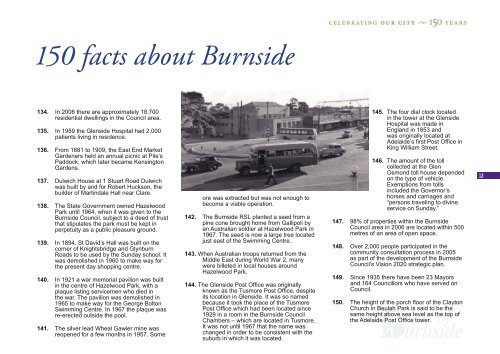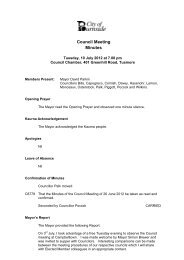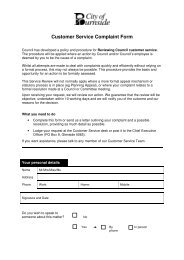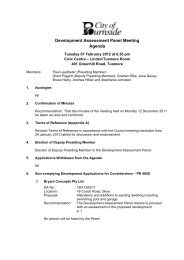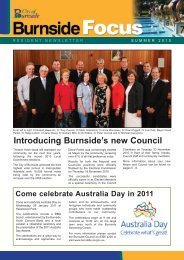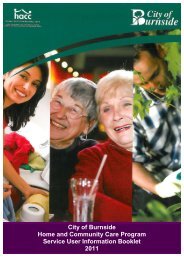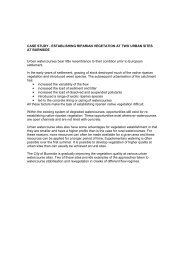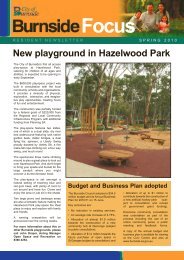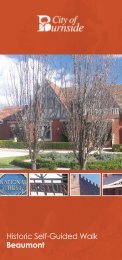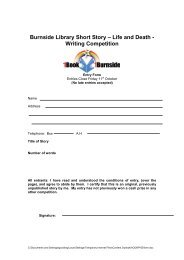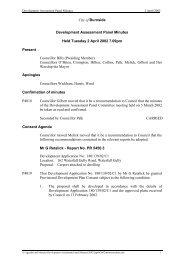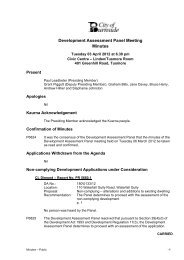Special Council Meeting - City of Burnside
Special Council Meeting - City of Burnside
Special Council Meeting - City of Burnside
You also want an ePaper? Increase the reach of your titles
YUMPU automatically turns print PDFs into web optimized ePapers that Google loves.
150 facts about <strong>Burnside</strong><br />
134. In 2006 there are approximately 18,700<br />
residential dwellings in the <strong>Council</strong> area.<br />
135. In 1959 the Glenside Hospital had 2,000<br />
patients living in residence.<br />
136. From 1881 to 1909, the East End Market<br />
Gardeners held an annual picnic at Pile’s<br />
Paddock, which later became Kensington<br />
Gardens.<br />
137. Dulwich House at 1 Stuart Road Dulwich<br />
was built by and for Robert Huckson, the<br />
builder <strong>of</strong> Martindale Hall near Clare.<br />
138. The State Government owned Hazelwood<br />
Park until 1964, when it was given to the<br />
<strong>Burnside</strong> <strong>Council</strong>, subject to a deed <strong>of</strong> trust<br />
that stipulates the park must be kept in<br />
perpetuity as a public pleasure ground.<br />
139. In 1894, St David’s Hall was built on the<br />
corner <strong>of</strong> Knightsbridge and Glynburn<br />
Roads to be used by the Sunday school. It<br />
was demolished in 1960 to make way for<br />
the present day shopping centre.<br />
140. In 1921 a war memorial pavilion was built<br />
in the centre <strong>of</strong> Hazelwood Park, with a<br />
plaque listing servicemen who died in<br />
the war. The pavilion was demolished in<br />
1965 to make way for the George Bolton<br />
Swimming Centre. In 1967 the plaque was<br />
re-erected outside the pool.<br />
141. The silver lead Wheal Gawler mine was<br />
reopened for a few months in 1957. Some<br />
ore was extracted but was not enough to<br />
become a viable operation.<br />
142. The <strong>Burnside</strong> RSL planted a seed from a<br />
pine cone brought home from Gallipoli by<br />
an Australian soldier at Hazelwood Park in<br />
1967. The seed is now a large tree located<br />
just east <strong>of</strong> the Swimming Centre.<br />
143. When Australian troops returned from the<br />
Middle East during World War 2, many<br />
were billeted in local houses around<br />
Hazelwood Park.<br />
144. The Glenside Post Offi ce was originally<br />
known as the Tusmore Post Offi ce, despite<br />
its location in Glenside. It was so named<br />
because it took the place <strong>of</strong> the Tusmore<br />
Post Offi ce which had been located since<br />
1929 in a room in the <strong>Burnside</strong> <strong>Council</strong><br />
Chambers – which are located in Tusmore.<br />
It was not until 1967 that the name was<br />
changed in order to be consistent with the<br />
suburb in which it was located.<br />
145. The four dial clock located<br />
in the tower at the Glenside<br />
Hospital was made in<br />
England in 1853 and<br />
was originally located at<br />
Adelaide’s fi rst Post Offi ce in<br />
King William Street.<br />
146. The amount <strong>of</strong> the toll<br />
collected at the Glen<br />
Osmond toll house depended<br />
on the type <strong>of</strong> vehicle.<br />
Exemptions from tolls<br />
included the Governor’s<br />
horses and carriages and<br />
“persons traveling to divine<br />
service on Sunday.”<br />
147. 98% <strong>of</strong> properties within the <strong>Burnside</strong><br />
<strong>Council</strong> area in 2006 are located within 500<br />
metres <strong>of</strong> an area <strong>of</strong> open space.<br />
148. Over 2,000 people participated in the<br />
community consultation process in 2005<br />
as part <strong>of</strong> the development <strong>of</strong> the <strong>Burnside</strong><br />
<strong>Council</strong>’s Vision 2020 strategic plan.<br />
149. Since 1935 there have been 23 Mayors<br />
and 164 <strong>Council</strong>lors who have served on<br />
<strong>Council</strong>.<br />
150. The height <strong>of</strong> the porch fl oor <strong>of</strong> the Clayton<br />
Church in Beulah Park is said to be the<br />
same height above sea level as the top <strong>of</strong><br />
the Adelaide Post Offi ce tower.<br />
12


